Kitchen Project #24: Peach creme caramel
Exploring and testing egg whites plus a love letter to tinned fruit
Hello,
Welcome to another edition of Kitchen Projects, my recipe development journal. It’s lovely to have you here.
One of the biggest questions I get is “What can I do with all my leftover egg whites?” and today, I’m here to start answering it. Cannot wait.
Over on KP+, I’m going through my archives of classic recipes to see if I can easily swap the whole eggs for egg whites and what the difference (if any!) is. This way I’m hoping to build a list of go-to list of bakes you can make when you’ve got spares.
First up, my go-to brownies recipe - they are fudgy yet mousselike, rich yet balanced. No matter if you use whites or whole eggs, it’s a bloody great brownie recipe which I hope can be your new fave.
If you’re enjoying KP and would like to support the newsletter and get access to all the extra content, including recipe and community chat threads (my fave), it’s easy! Just click here:
Alright, let’s get on with the newsletter.
Love,
Nicola
PS. The seasonal KP+ cooking thread “May: What’s Cooking” will launch tomorrow! Sorry it’s late, I appear to have been moving house for the last 3 months and have lost a sense of time. See you there.
What’s that in the back of the freezer?
Look inside any bakers freezer and what do you find? Well, probably a bunch of random unlabeled doughs (guilty) and black bananas (double guilty), but look beyond that and what is there? Egg whites.
I admit that I’ve played my part in this too - all of those creme pats of KP’s past may have had you throwing egg whites to the side. Well, I’m here to help make it up to you.
Of course you can make meringue buttercream, or roulades, or meringue nests, or pavlovas, or angel food cake. These are all worthy recipients for your stash. But judging by the number of egg whites I have in my freezer, you might need some more options up your sleeve.
This is a first in a series focused on getting those egg whites in action. From biscuits, to cookies to custards (YES, even custards), I’m going to be testing the limits of egg whites and try and run down that egg white store of yours. Move over yolks.
So the questions I pose today:
Can you make custards or cream based desserts with ONLY egg whites?
And even if you *can*.... Should you?
You’ll be happy to know that the answers are firmly yes and more yes.
Let’s do it!
All about egg whites
I’m not surprised if the idea of an egg white custard sends you running to the hills. BUT STICK WITH ME. Because I’m here for it and hoping youll be blown away. If only for morbid fascination, give me a chance to change your mind and chip away at that freezer stash of egg whites I know you have.
The story of this recipe begins all the way back in March 2020. I was catching up on the phone with my baking mentor Adam Sellar (he doesn’t use social media so I can’t link to him!) and I made a joke about making a custard tart with egg whites instead of yolks.
He didn’t find it funny.
Not because he’s *that* brutal, but because he knew all about a world I didn’t know existed. It was on this fated call that he told me all about the OG panna cotta - cream set without gelatin and instead, set with egg whites.
Ok, if you’re anything like me, you might be thinking ‘that sounds absolutely gross’. But wait! Over the years of working in kitchens, making custards with whole eggs is nothing new - lemon tart, for example, uses the whole thing. But egg whites only? Surely not. I’m not sure why it seemed so alien to me, but it did. I put it to the test.
Considering the egg whites
I whipped up a few tests based on a quick Google search: Cream and sugar are heated up then blitzed with egg whites and then baked gently in the oven. Sounds underwhelming right? But I was absolutely blown away by the results. It was smooth, creamy and didn’t have any of the eggy or stringy qualities I was worried about.
It turns out, the lack of flavour in egg whites is actually the greatest strength here. The flavour is so clean and the texture was meltingly perfect.
There’s not much I fear more in the kitchen than something tasting ‘eggy’. Ugh. Even writing the word makes me shiver. And I had a lot of fear here, especially since the ‘eggy’ flavour/scent arrives when egg whites are overcooked.
When eggs begin to coagulate at 60c, sulphur compounds begin to be released, which is totally normal and at this stage doesn’t release any scent. That story begins to change after 80c, which is why you need to be extra careful with the cooking of whites only.
Another way to counteract the sulphuric scent is to lower the pH - vinegar in water when poaching eggs helps, for example. But that’s not always practical when it comes to dessert applications. Although it’s helpful to keep this in mind, for today’s KP we’re going to be focusing on the cooking technique to keep us in the clear.
One of the things to note when using egg whites is what the impact on the final texture will be. Consider a hard boiled egg:
A yolk, even when hard boiled, can still be mashed, grated and can be pushed around to look fairly homogenous thanks to its fat content and the emulisifer lecithin that is present. A white, however, will break, crack and cannot stay homogenous. So, a custard set with whites won’t be able to wobble or change shape much and will be on the firmer side, but it will hold its shape very well and be ultra smooth.
Getting the ratio right
To get started on the KP version of the recipe, I looked at the percentages of yolk to cream for a classic custard tart which comes in at 58%. Based on other recipes out there, it looked as though an egg-white cream combo was generally 20-30% egg whites to cream.
But since this experiment is all about trying to use up the egg white store, I decided to test a few different % to see what was both 1) the most delicious and 2) used up a decent amount of egg whites, too. Of course, point 1 will take precedent but God, wouldn’t it be fab if I could make point 2 work, too?
100% aka equal parts egg white and double cream
I figured I may as well go the whole hog. The result? A bit strange. The eventual texture was similar to silken tofu but slightly more gelatinous - slippery and wet. Much more like a silken tofu/soy pudding popular in Chinese cooking. Hopefully you can tell by this pic:
Although the amount of egg whites used would be heroic, it didn’t quite pass the first test of being the most delicious. Next!
50% egg white to cream
Although I didn’t have high hopes for this and was sure I would have to go into the 20%-30% range, I was actually very happy with the results! I feel like it struck the right balance between texture, taste AND using up egg whites:
I was happy to have comfortably doubled the ratio that I’d seen used in other recipes and also think the use of egg whites in a more dominant ratio makes the whole dessert lighter, cleaner and just right.
Using milk
I was wondering if I could lower the double cream content and set a milk based custard with the whites instead. I mixed up a batch of all milk with whites and set it. I was pretty nervous about getting the set right so I took it out a bit too early. When I turned it out the result was… burrata?
The flavour was nice, but because whites have zero fat, it’s really important to get a bit of fat from elsewhere otherwise the flavour is a bit lacking. So, although you can use a mixture of milk and cream in my final formulation, it’s sensible to keep a higher proportion of cream. Afterall, fat = flavour. Even though the bake was definitely my fault, I didn’t bother trying it again as the flavour simply wasn’t there.
Taming the whites for custard
Making egg whites behave can be a challenge - cold, fresh egg whites can be so viscous and thick that it’s really hard to work with them without introducing air. And as we all know, air is the enemy of custards. Trapped air can totally run havoc with your super smooth desserts which can be so frustrating and leave odd pockets of texture throughout.
I’ve seen people use a hand blender to break down the whites but after my tests, I think it needs to be gentler than this: The best way to break down your egg whites, I think, is by forcing them through a sieve with the help of a spoon and a fork. Bubbles or froth don’t travel through as much as you’re able to break things down much easier. My recommendation is to break up the whites as gently as possible with a fork and then pass them through a fine sieve several times.
I also apply this technique to the final mixing of the custard by tempering the egg whites and warm milk literally *in* a sieve. If there are any pesky viscous bits of egg white, the warm milk can help break these down.
The final mix will also be poured through a sieve twice so there’s ample opportunity to get any unpleasant bits out. If you’ve got any concerns the rule is always pass it through the sieve again. Oh, and if you find that there are bubbles hanging around in your final mix, feel free to burst these with a toothpick or sharp knife before baking.
For the love of tins
Ok ok, I know that things in tins sometimes freak people out. I took to my instagram story to find out how people felt about the tinned stuff and it was a 70:30 result in favour of PRO. Although there were a few no voters who DM’d me to say that their ‘No’ vote did NOT include peaches. I don’t think I’ve ever met someone who doesn’t love tinned peaches. They are always perfect.
Living in the UK, the window for good peaches - home-grown or imported - is slim. And since we’re still in the mid-season fruit funk, I’m overjoyed to look at the long-life aisle for a fix. And even if for some reason you’re not convinced, I promise once you’ve dressed these up a bit, you’re in for a thrill.
Side note, I have a bit of an allergy to raw stone fruit which doesn’t happen since the tinned peaches are already poached. Not sure if this is useful info for anyone but it helps me enjoy stone fruits all year round without getting an itchy mouth!
Introducing peaches
After I tasted the beautiful clean pure taste of the set cream, I knew immediately that peaches would go hand in hand with it. Tinned peaches plus cream? Is there anything better? What about caramel peaches and cream? Yeah. That’ll do it. Peach creme caramel. This recipe has real tart tatin energy too. My fave.
So, this was easier said than done. I was hoping it would be simple - just fill the tin with caramel then carefully and neatly line the base of the tin with peaches, hoping that the slices would gently cook in the caramel.
Unfortunately, it wasn’t going to be that easy. I ran into two major problems:
When I poured the custard on top of the peaches, they would get displaced and float to the top
When it baked, custard seeped through the peaches and ruined the beautiful peachy pattern on top
To try and fix these issues, I first tried placing the peaches in the base of the tin and putting the caramel on top, but this was really temperamental and didn’t work so well. I had disappointing results when I turned it out.
My next fix was to introduce some additional liquid into the caramel (in the form of tin peach puree although it does also work with water) so it wouldn’t set hard immediately and I could instead press the peaches into it, hoping this would create a bit of a seal. This worked very well but still, there were a few floaty bits.
Finally to fix this, I turned to my favourite friend - the freezer. Before filling with custard, I let the peaches set firm and the caramel to harden up a bit so it wouldn’t get dislodged. The results? Perfect - nothing was displaced and when I turned it out the next day, I finally got what I was looking for - a beautiful peachy caramel, neatly organised and glowing. A genuine thrill!
Are water baths really necessary?
I have to admit I roll my eyes whenever I see a waterbath in a recipe. Even though I know it’s important and very easy, for some reason I always think it’s going to be hard work. When it comes to this custard, the answer is yes - it is necessary.
I baked a few tests sans waterbath and unfortunately these formed a crust during the bake which developed a really sulphurous crust that wasn’t pleasant to eat and made the whole thing way less desirable and definitely got the essence of the dreaded four letter ‘E’ word.
Another technique I’ve seen is to cover your creme caramel with foil whilst its baking to stop a crust from forming on top. Totally understand why you’d want to do this though I don’t find the slightly thicker top layer unpleasant to eat/I don’t really notice it when eating the final product, so I prefer not to use foil.
If you would like to, then gently lay foil over your ramekin/tin and stab a few breathing holes in the top before baking.
Jiggle it
Although I’m satisfied using the jiggle test when it comes to yolk based custards, we are definitely walking a more dangerous line when it comes to an egg white custard and I don’t trust my jiggle jedi sense enough. Remember that whole sulphur thing I mentioned earlier? We really do NOT want that involved in our beautiful dessert.
So, it’s time to grab your handy pocket thermometer and even though it might hurt you to do so - i’m going to ask you to stab your dessert.
I did a cake class at Konditor and Cook once and the teacher told us how she can’t bear testing her cakes with a knife/skewer because it felt like she was stabbing something she loved. And I do get this point of view - it does feel pretty terrible to stick a stake through something you’ve been so painstakingly taking care of. But it must be done! You’re looking for 74c.
That being said, we do still rely on the jiggle a bit here - there’s no point temping the custard unless it is rippling in a jelly-like way, so I like to wait until I’m pretty certain it’s time to pull it out and then temping to confirm.
A word of warning - when using a water bath and the jiggle test together - be careful! Whilst testing this recipe I kept accidentally splashing my custard! The final result wasn’t actually affected too much once I’d mopped it up genly with kitchen-roll but worth keeping in mind when you’re shaking things about in the oven.
Demoulding
Although you can eat the set cream straight out of the ramekin you bake it in, there is something lovely about turning it upside down and letting the caramel seep out.
Demoulding can be a bit challenging. Firstly, you need to leave your creme caramel long enough that the sugar liquifies enough. Although a little caramel is likely to be leftover no matter how long you leave it, at least four hours is essential, otherwise you’ll be left with something like this:
I’ve watched a lot of youtube videos on how to demould these and I think running a sharp knife round the edge (the most popular way) is the best. I’ve seen a few people knocking the side of the tin with the heel of their hand to dislodge it but I think this cracks the whole thing when you’ve set it gently.
The finishing touches
To finish off the dessert, spoon any remaining caramel from the pan. Peaches and basil is one of my favourite EVER combinations whether it’s sweet or savoury (peach, tomato, mozzarella and basil salad is ridiculously delicious) so, if desired, add a little pop of colour to your final dessert. And no, it’s not pointless garnish - it genuinely tastes wonderful.
Infusing and adapting
This base recipe works perfectly for infusions since it is predominantly cream. I would say it works even better than ‘normal’ custard tarts since the egg whites impart very little flavour, leaving loads of room for your infusions to take center stage.
For today’s recipe, I did a classic vanilla infusion but I want you to go WILD! The opportunities are endless here and I want you to feel confident to adapt it to your tastes. I tested this base recipe with a cacao nib infusion (25% of toasted cacao nibs to cream, cold infused for 24 hours) as well as a hot infusion with lemon, orange and cinnamon. They worked beautifully. The directions are exactly the same. So, if you feel like playing around with the flavours - do it! And let me know what you choose.
If you would prefer to try this as a classic creme caramel, omit the whole peaches/freezing step and just proceed with the recipe as is. You’ll be rewarded whatever you choose!
A note on creme caramel vs. flan
I’ve tried to understand the difference - if there is one! - between creme caramel and flan. From my internet research, my understanding is that the two are very similar (or even, the same!) but are referred to differently. In the US, Spain and the Phillipines, it’s known as Flan (do you remember the Sabrina the teenage witch giant flan episode? I do) whilst in the UK and France it’s known as Creme Caramel.
I am 100% not an expert and would love to be educated, so please comment below if you know more on this subject!
Alright let’s do this.
Peach and vanilla creme caramel
Makes 1 x 6 inch, or 6 x single rammekins
Please don’t use a tin with a springform or separate base as the custard will leak.
For the custard:
270g double cream
40g caster sugar
135g egg whites
½ vanilla pod
For the caramel
70g sugar
35g peach puree (blitz up tinned peaches in a food processor) OR 20g water (you need less water than puree as it has less body!)
1 x 400g tin of peaches
To finish - basil leaves. I have a whole plant so I just pick off the baby leaves
Directions
First, infuse the cream for the custard. Heat the milk and sugar up with the vanilla pod until simmering then cover and leave for an hour
Now, make the caramel - heat the sugar in a frying pan and leave it to melt - you can use a whisk or a spatula to help it along once it’s almost all there
Let the caramel go DARK. Almost smoking! You do need to be brave here - and once it’s there, whisk in your puree or caramel until homogenous. Be aware it will sputter
Pour the caramel into ramekins or into the dish and swirl to cover the base. Be careful as the pan heats up from the caramel, so use a tea towel to protect yourself!
Drain peaches and slice each peach into three thinner slices
Place the peaches into the caramel, going from the outside in, ensuring there are as few gaps as possible and pressing the slices into the caramel slightly to fuse
Put into the freezer until firmly frozen. I would say 30 mins - 1 hour! You can leave it for as long as you want at this stage
Once you’re satisfied the peaches are firm, you can continue with the custard
Set oven to 140c fan
For the custard, break down the egg whites as much as you can with a fork with gentle movements then pass through a sieve. You want to whisk/break them down as much as possible without introducing air. FORCE THEM THROUGH!!!
Reheat the cream until warm (not boiling - I think 70c is a good temp) and then pour over the whites very slowly to temper, whisking all the time (I like to keep the sieve in there incase there are any pesky solid bits from the first temper
Pour the rest of the cream over and pass it all through the sieve. Whisk it well
Pass the whole mixture through a sieve several times until you’re satisfied it is smooth and everything is combined
Now you’re ready to bake! Pour the custard on top of the frozen peaches very gently. As it is warm, it will defrost the base slightly so go gently as not to dislodge anything
Put the ramekins/tin into a larger baking dish. Pour boiling water so it reaches ½ way up the side of the dish
Bake for around 50 mins until the internal temp is 74c and there is a lovely jiggle
Cool in the fridge and allow to set for at least 4 hours although I prefer overnight
To demould, use a sharp hot knife and go around the edge of the tin. Put a place - with sides - on top and flip it over. You might need to wiggle it side to side a bit to dislodge it but it should come out. You can hear it coming out! It is quite fun
Decorate with mini basil leaves if desired. You can eat immediately or leave in the fridge for later. I think its easier to cut once its been in the fridge for 1-2 hours after demoulding
Sorry, but cutting is a bit hard - I find it easiest to use a serrated knife to slice through the peach layer and then use a sharp knife to slice through the rest. Two pronged approached!
This will last in the fridge for 3 days

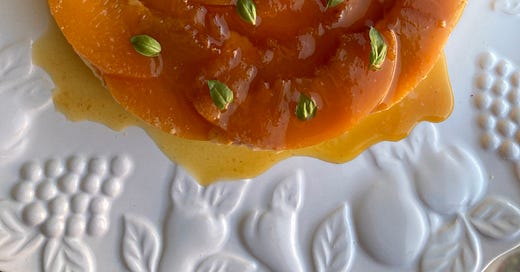


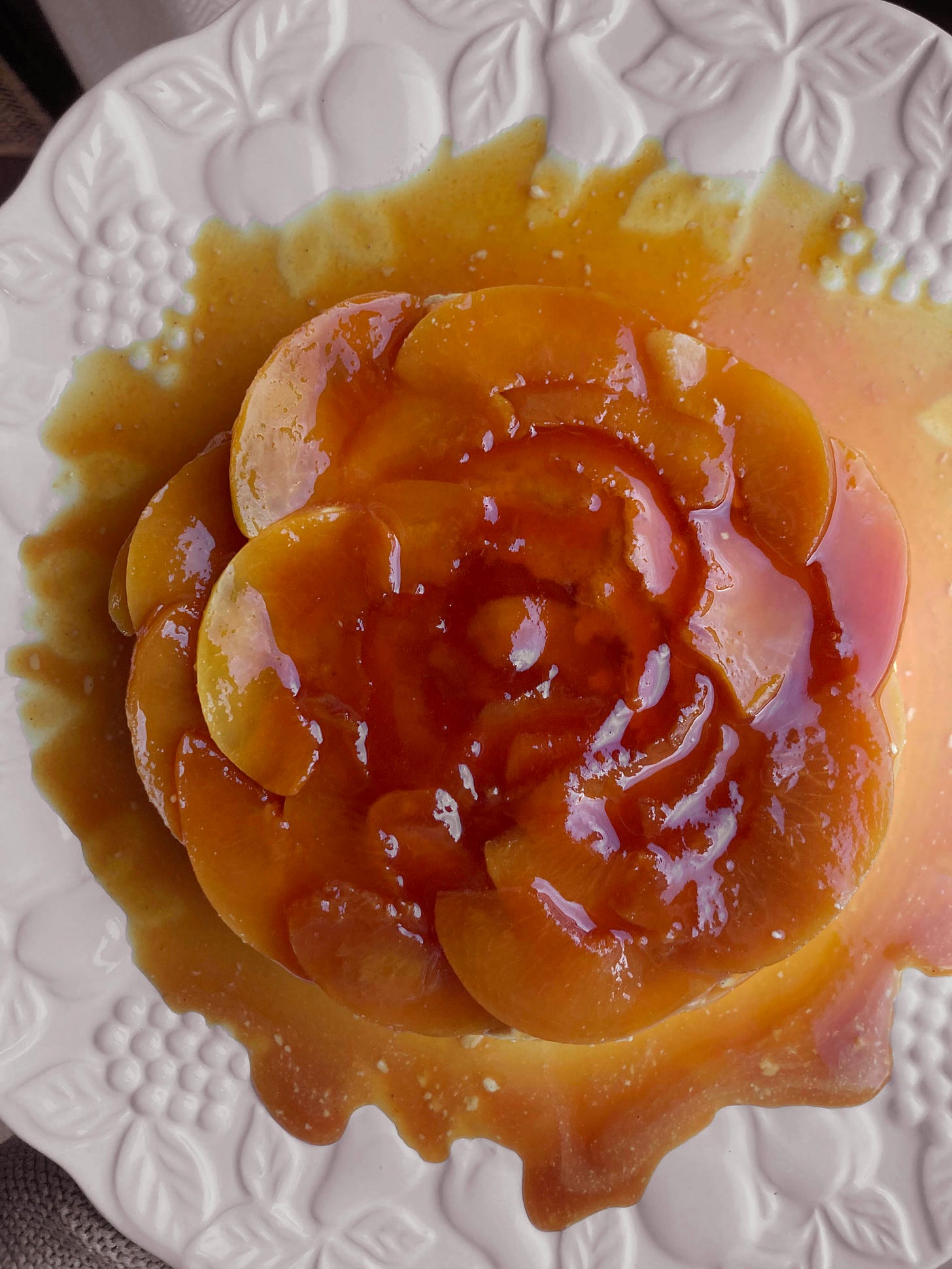
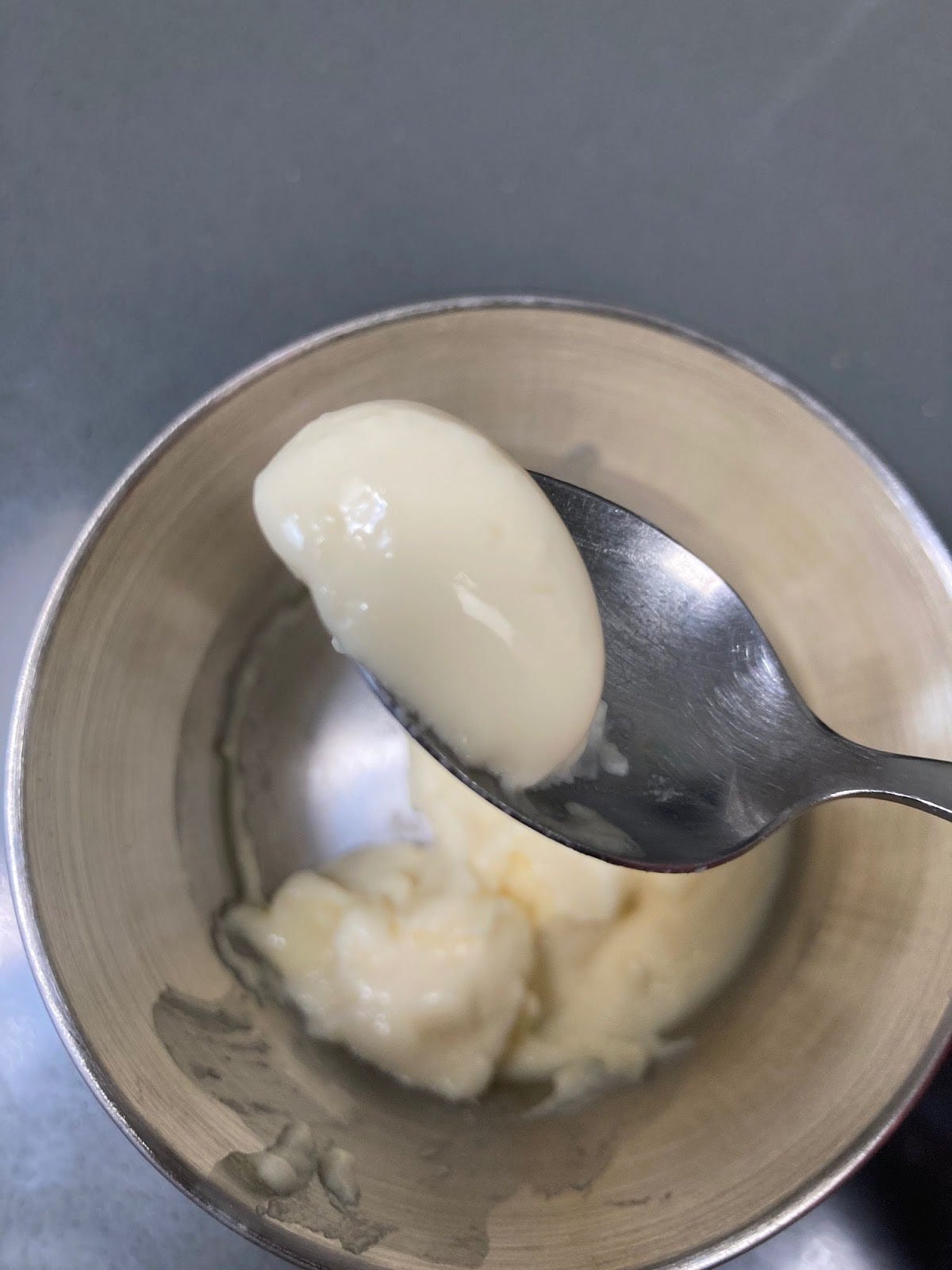
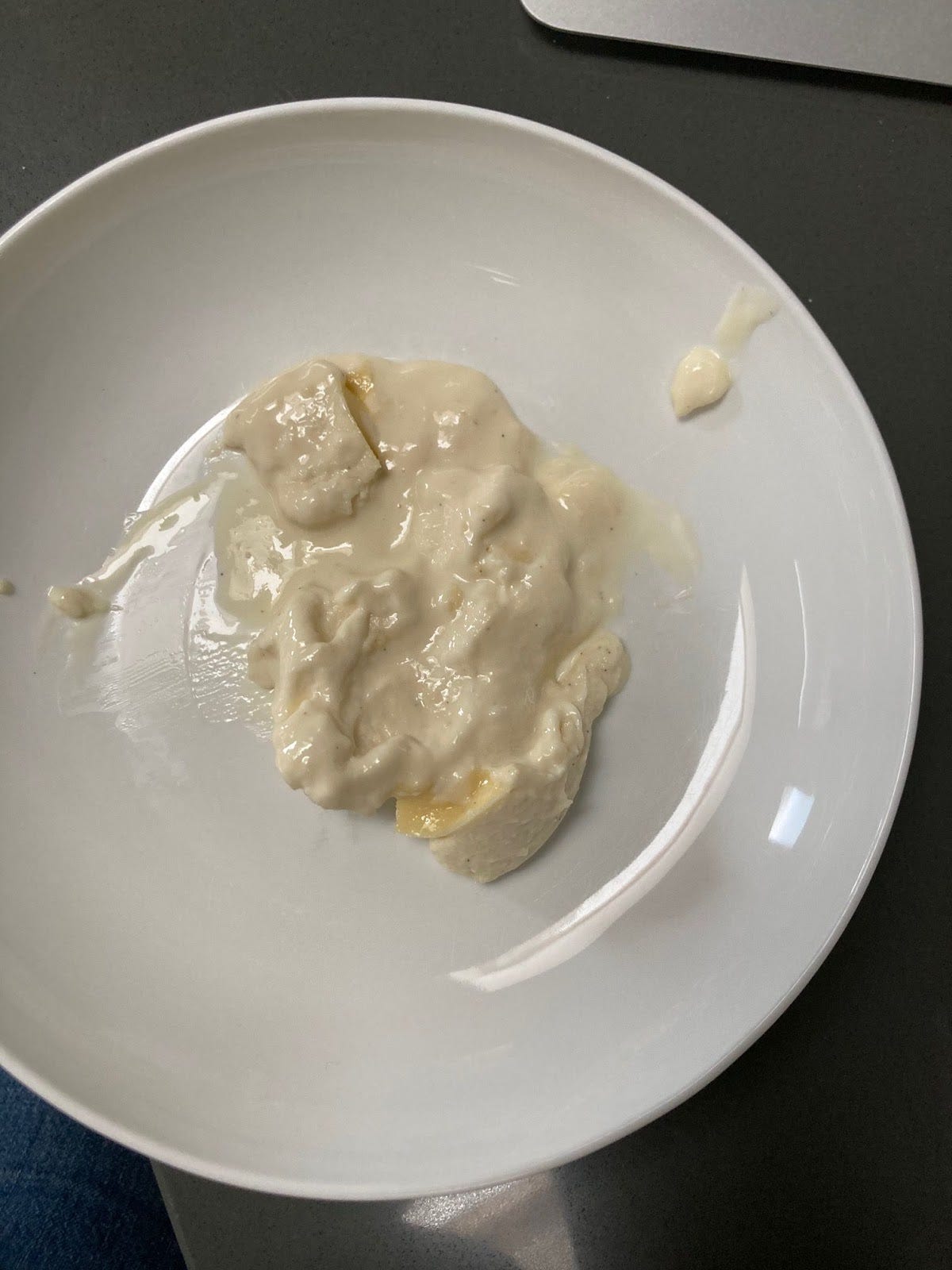
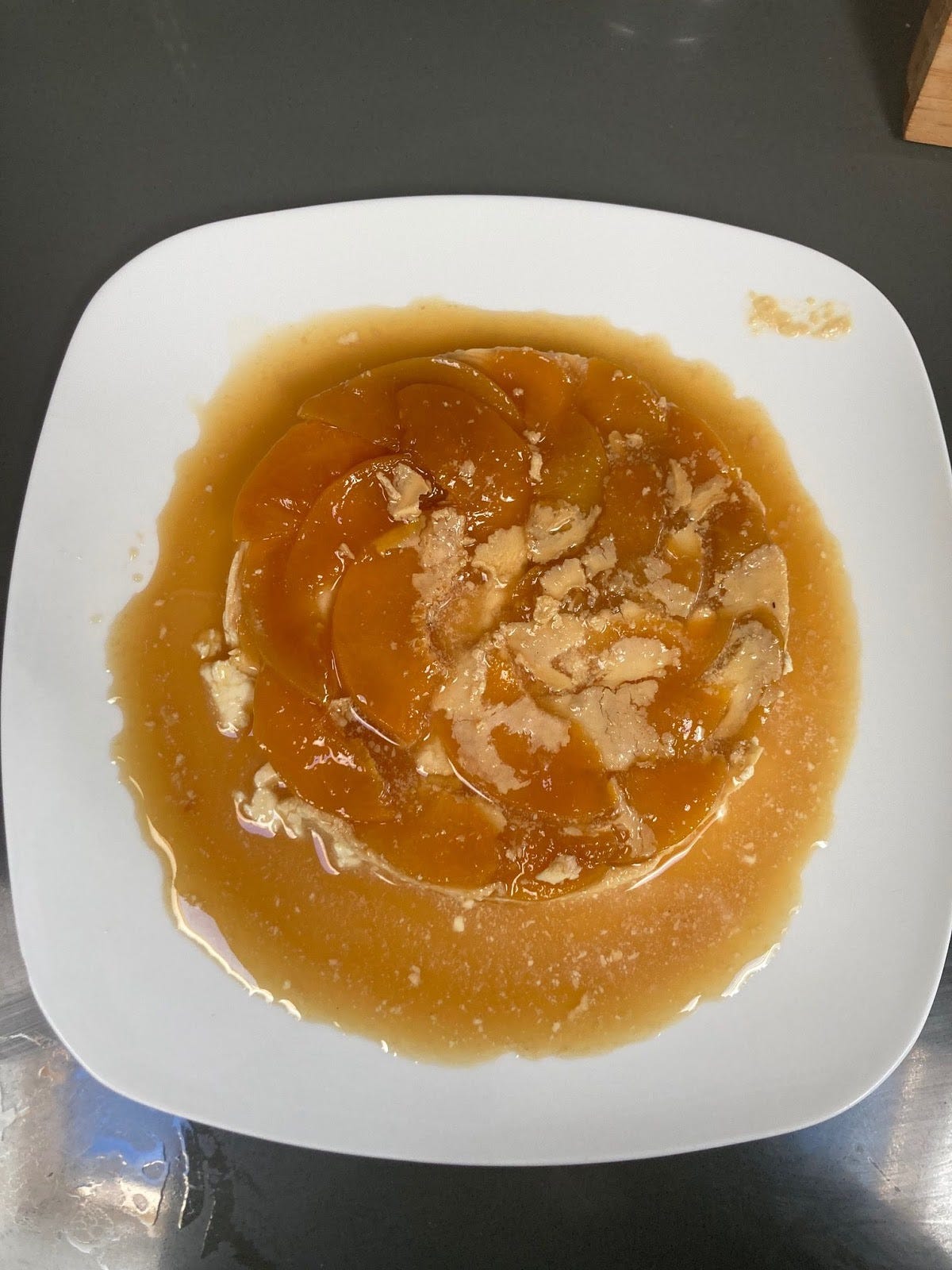
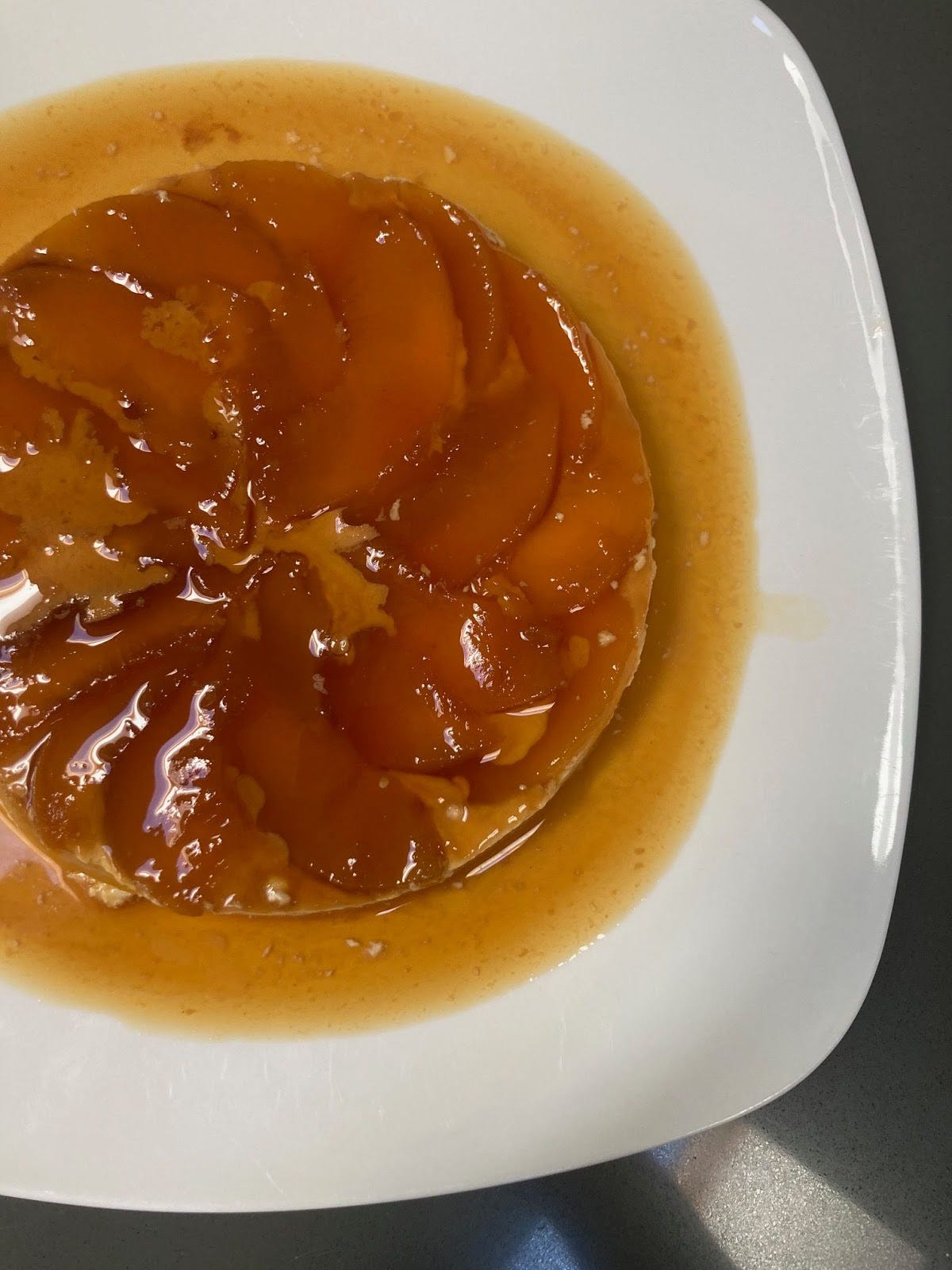

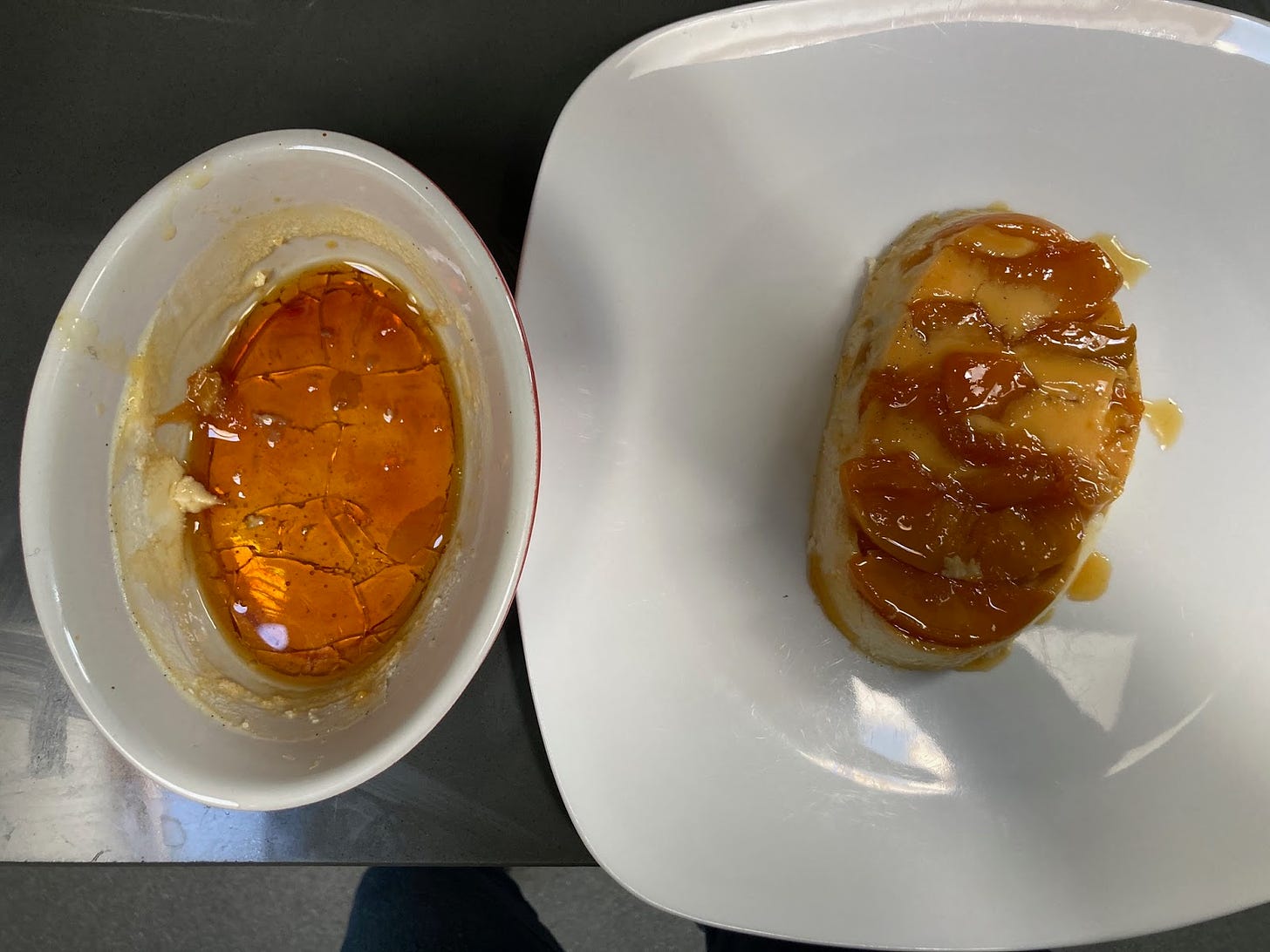
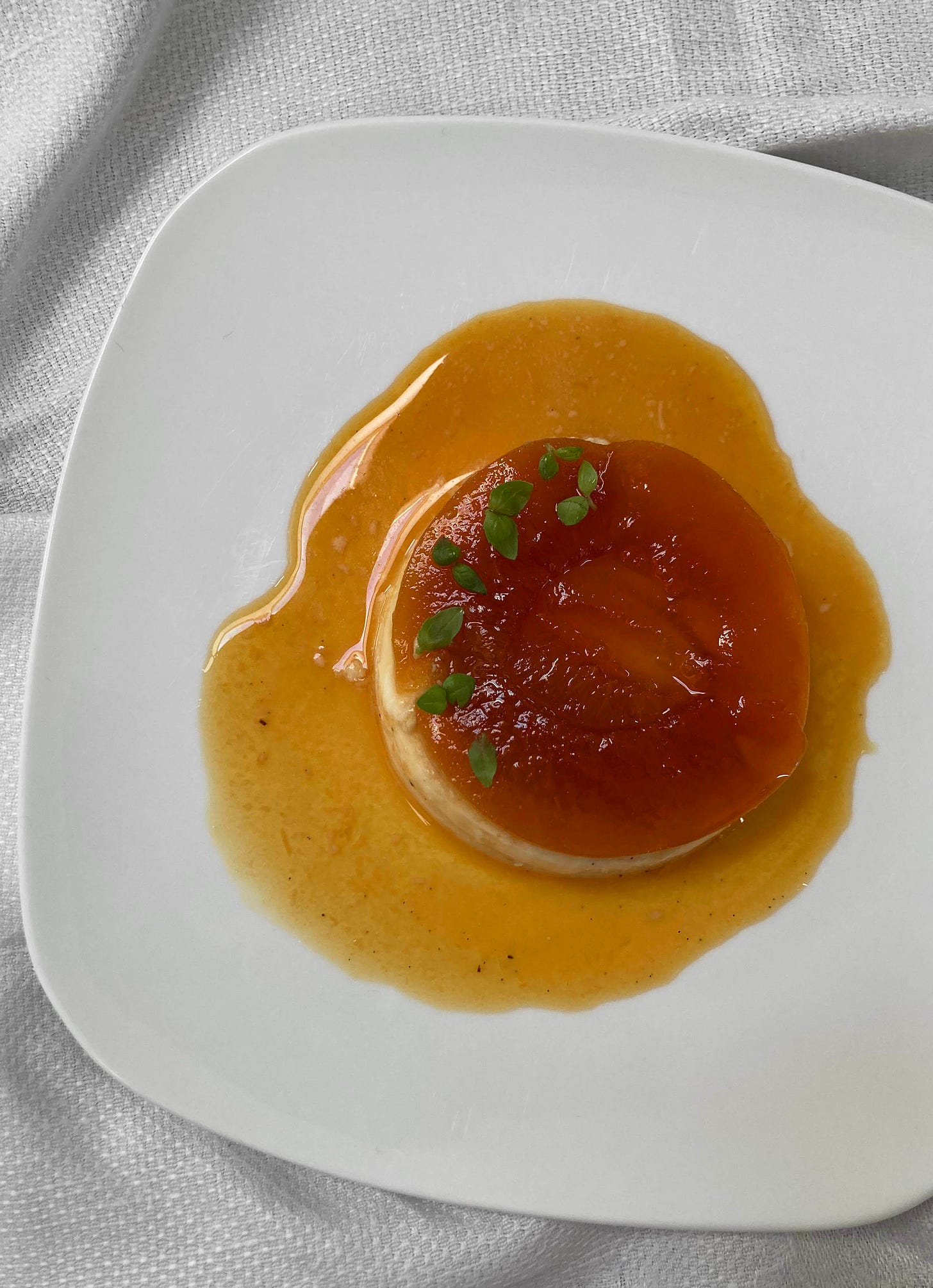
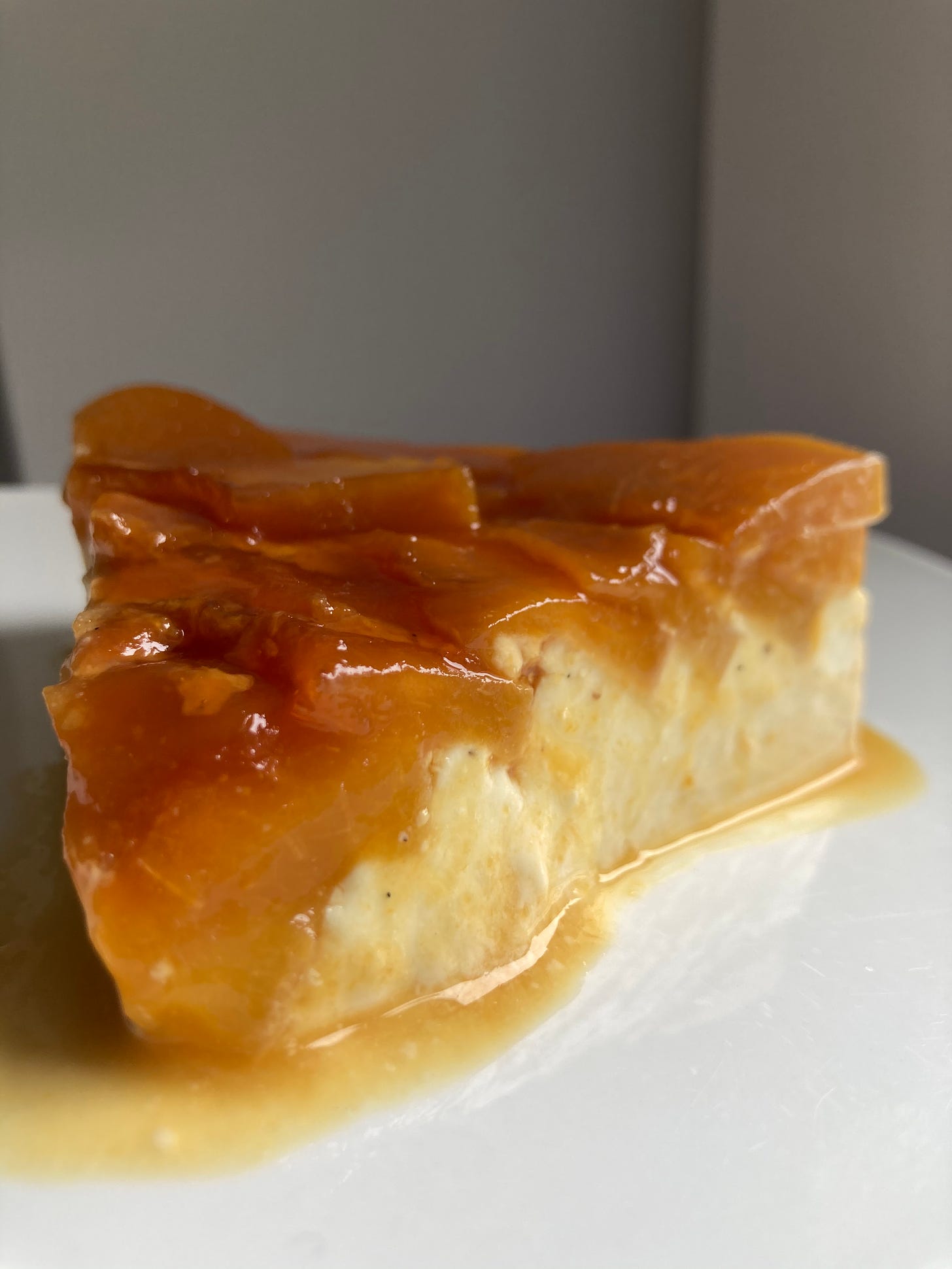
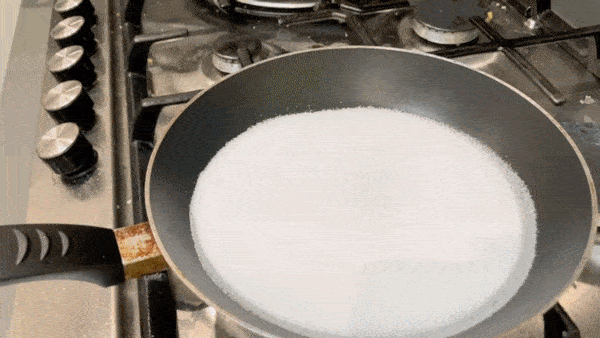
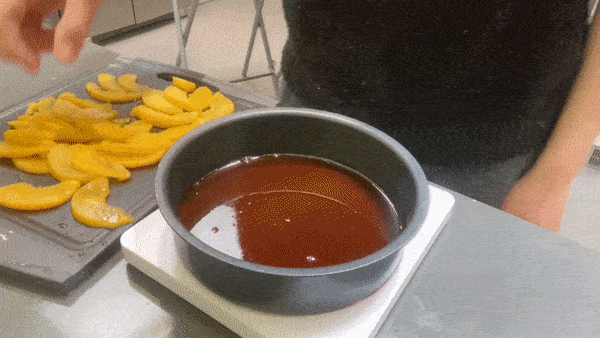
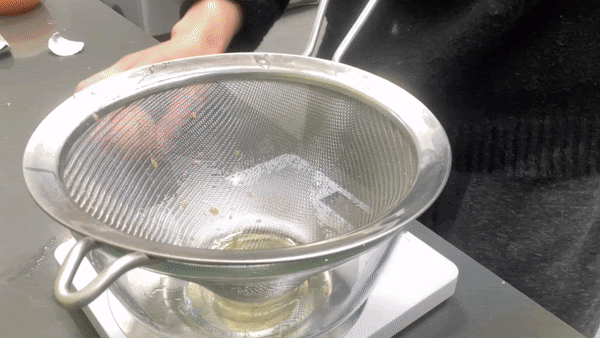
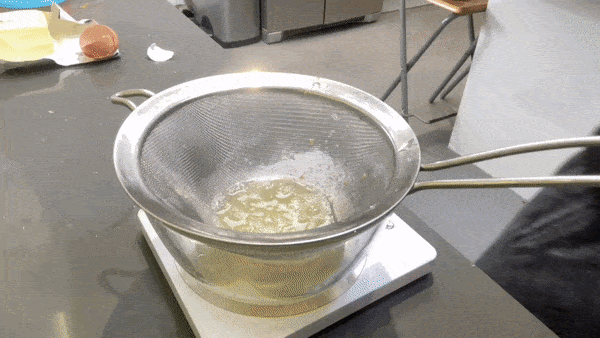
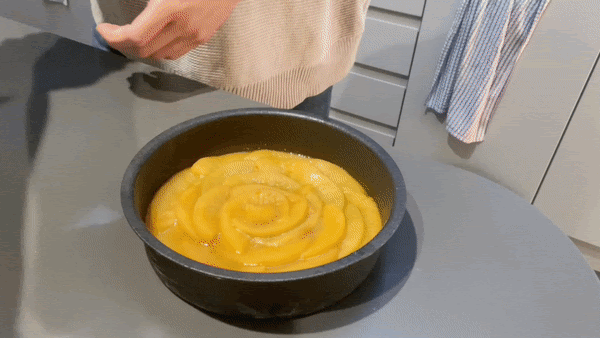
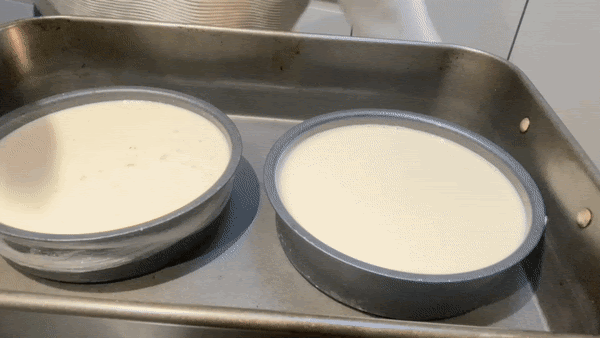
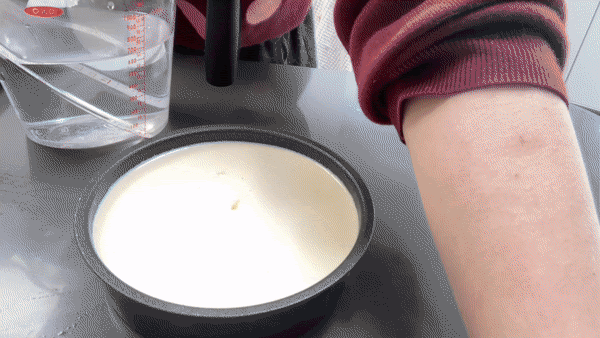

Hi! Would this work with mangoes?
So grateful for this and the brownie recipe - I'll be moving house soon and CANNOT move all the frozen egg whites with me!!